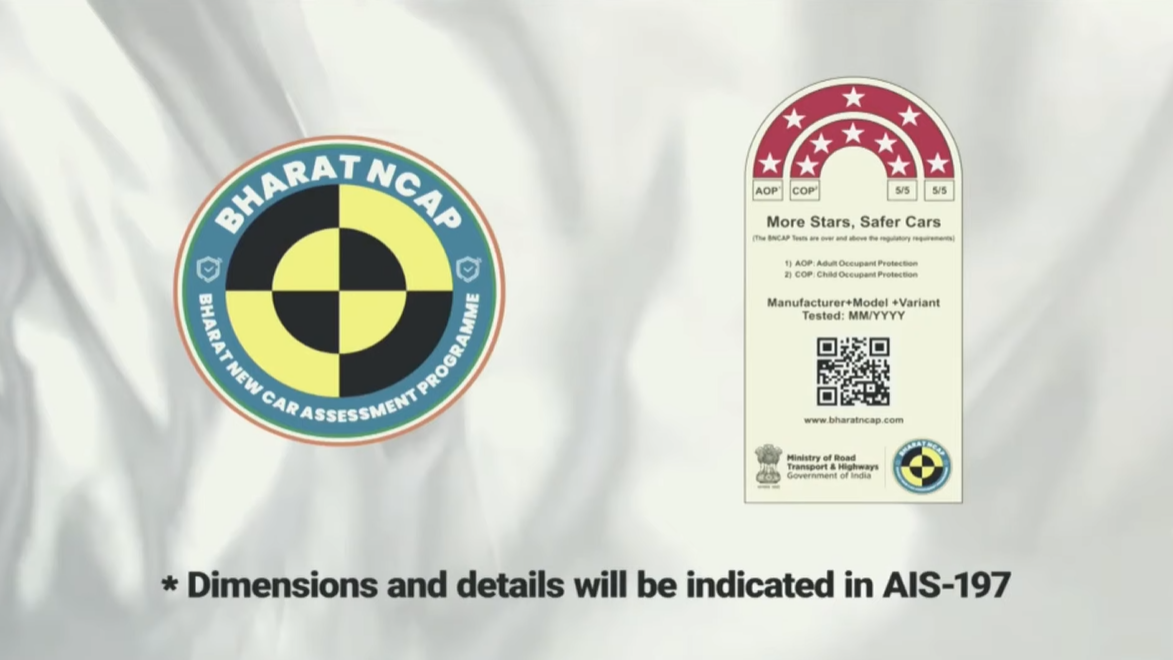
A request to test more than 30 models under the new Bharat NCAP program has been already received, said Minister Gadkari.
India has become the fifth country in the world today to have its own crash test rating structure. Global NCAP along with the Ministry of (MORTH) have jointly announced Bharat NCAP crash test ratings. India’s own car crash test ratings will come into effect from October 1, 2023. The announcement confirming the approval of the BNCAP official notification was made by Nitin Gadkari, Union Minister of Road Transport and Highways of India, earlier today.
At the event, Nitin Gadkari also announced that BNCAP has already received over 30 requests for testing models and says he is happy to see the automotive industry’s acceptance of the BharatNCAP program. Nitin Gadkari also acknowledged that besides car safety, road engineering, which is also a big problem is being addressed by the ministry.
He also said that the cost of testing a car under BNCAP program is around Rs 60 lakh whereas a similar test would require around Rs 2.5 crore if done overseas.
Anurag Jain, Secretary, Ministry of Road Transport and Highways said that introduction of BNCAP will also add to make the Indian automotive industry more export oriented.
Also present at the event, David Ward, executive director for Global NCAP said, India has shot up as the most important country globally in terms of scaling up road safety. The country as part of the nation assuming the G20 presidency is moving far ahead as compared to other countries that are not doing as well.
The last decade, India was the most improved country among the G20 countries. G20 accounts for over 80 percent of cars sold.
Bharat NCAP: aligned with global testing protocols
As announced earlier, the Indian government has aligned Bharat NCAP’s testing protocol with global crash test protocols, which implies that the programme will give a star rating between 1-5 for cars tested, with 1 being the lowest. Based on the performance of the vehicle in the tests, the model will be awarded a separate star rating for adult occupants (AOP) and child occupants (COP).
The parameters for the star rating include various factors like pedestrian-friendly design, the structural safety of the car, provision of active and passive safety assist technologies and the safety of adult and child occupants.
The term ‘Safety assist technologies’ is also an evaluation area however seat belt reminders is mandatory for the front row only, this should have been mandated for the rear row too given its simplicity and low cost.
Bharat NCAP: which vehicles qualify?
The Bharat NCAP crash test program is based on the Automotive Industry standard AIS 197. Vehicles falling under M1 category that have been approved for carrying up to eight passengers, in addition to the driver; has a gross weight lower than 3.5 tonnes; and is either manufactured or imported into the country will be eligible for the Bharat NCAP crash tests. Apart from combustion-engined vehicles sold in India, Bharat NCAP program will also test and rate CNG and electric vehicles.
Bharat NCAP: how does it work
1 .Car manufacturer nominates a vehicle model
2. BNCAP team will visit the manufacturing facility of that particular vehicle and will select the base variant through random sampling.
3. The selected vehicle will be then dispatched to the BNCAP testing center by the manufacturer.
4. This selected unit of the vehicle will be crash tested and the process will be witnessed by the representatives of the car manufacturer and the BNCAP team.
5. Test results will be compiled and shared with the car manufacturer followed by the BNCAP standing committee approval.
6. After standing committee approval, the star ratings and crash test results of that particular vehicle will be published by BNCAP and the certificate will be issued by CIRT (Central Institute of Road Transport)
Bharat NCAP: steps for evaluation process
Based on the global testing protocol, BNCAP program will evaluate vehicles based on Adult and Child occupant protection along with fitment of safety assist technologies.
The BNCAP crash testing specifies tests like Frontal impact test (Offset Deformable barrier), Side impact test and a Pole side impact test (conducted only or 3-4-5 star rating vehicles). The speed at which the vehicle will be crash tested remains at 64kph which is same as the global testing protocol.
Apart from the points given for crash tests, there are safety assist technology qualifiers for each rating. These include:
- Pole side impact (3-4-5 stars)
- ESP
- Pedestrian protection for all vehicles
- Seat belt reminder for front row ( 3-4-5 stars)
Bharat NCAP: how are the star ratings decided
Rating Adult (Child)
5-star 27 (41)
4-star 22 (35)
3-star 16 (27)
2 star 10 (18)
1-star 4 (9)
Expect more details on the crash test process, the testing speed and other parameters to be released soon.
